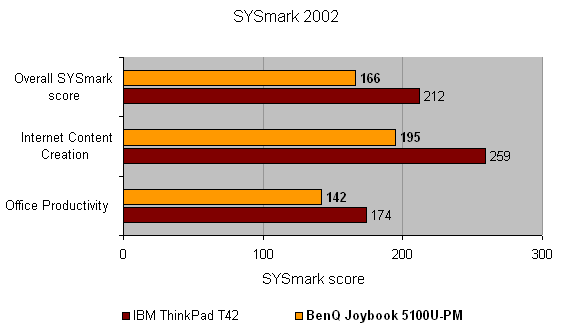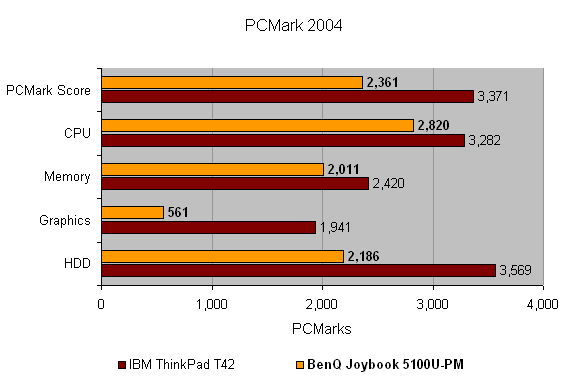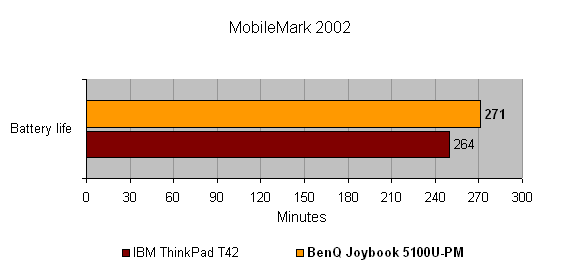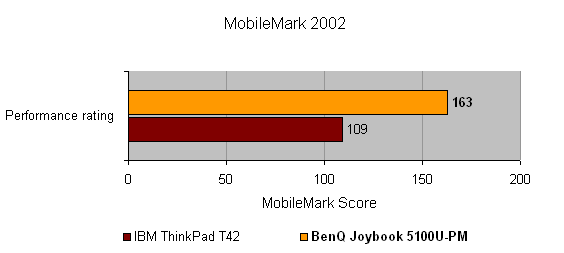BenQ Joybook 5100U PM Notebook Review
BenQ Joybook 5100U PM Notebook
BenQ has produced a decent notebook at a reasonable price, but how does this latest Joybook stand up to the strong competition?

Verdict
Key Specifications
- Review Price: £902.00
It’s official, notebooks are getting cheaper. This isn’t a new phenomenon; anyone interested in a typical desktop replacement will have noticed this trend for a while now. Where the reductions are new, however, are at the higher end of the market. Gaming machines such as the AJP D500E and Dell Inspiron 9100 are creeping within reach of the ordinary punter and even the sacred thin and light machines have begun to show signs of affordability with the release of models like the Toshiba Portégé A100. BenQ is the latest company to try to break ground in this latter category, and with its Joybook 5100U PM it has achieved reasonable success.
Now at first sight the Joybook 5100U PM is a confusing proposition because while it is reasonably light, it is not particularly small. In fact, its dimensions are 320 x 265 x 31mm (WxDxH) which is roughly the same size as a regular laptop yet it weighs only 2.4kg. Given that physical size inhibits mobility as much as weight I’m not sure I fully agree with BenQ’s description of the 5100U PM as ultra portable, although we may have just seen the world’s first fat and light. That said, considering that true ultra portable notebooks like the Sony VAIO X505 weigh less than 1kg, maybe it’s not that light either.
But if the 5100U PM rather cheats its way into the ultra portable category then certain benefits try to make up for it. Sporting a full size chassis means you have a full size keyboard, 15in screen and an integrated CD-RW/DVD-ROM drive. It would have been nice to see at DVD writer included but on a budget orientated model that still remains wishful thinking for the time being.
Looking at the rest of the spec, there are some obvious hints that the 5100U PM is a value model. The Intel Pentium M 1.5GHz processor is reasonable but it comes with only 1MB of cache unlike the newer Dothan based CPUs which are equipped with 2MB. The hard drive is an adequate but hardly capacious 40GB unit which spins at the slower 4,200rpm spindle speed, while the Intel integrated graphics, which share 64MB of the system RAM make gaming is a definite no-go area. That said, you do get 512MB of RAM and though the onboard wireless adapter is limited to 802.11b instead of the faster 802.11g standard, it’s still worth having.
Connectivity options cover most of the bases with three USB 2.0 ports, FireWire, Serial, VGA and S-Video. There is a Type II PC Card slot and a 3-in-1 card reader thrown in for good measure as well as modem, Ethernet, headphone, microphone and Infrared ports. In sum, the 5100U PM is hardly at the cutting edge but it offers a decent feature set for the money.
Visually, the 5100U PM is not unattractive either with a two tone colour scheme and semi transparent keys, though it does lack the wow factor of a machine like the Toshiba Portégé A100 with its silver and white design. General build quality is pretty good apart from the lid catch which is a little stiff, while the plastic used for the buttons of the touchpad is not of the same quality as the rest of the materials.
So what is it like in use? Well, the most striking thing is the screen, primarily because it’s limited to a 1,024 x 768 resolution. On a 15in display this looks huge and while I have to admit I know many people who prefer lower resolutions and more easily readable text than higher resolutions and more desktop real estate, this does take it to an extreme. The BenQ suffers in a similar way to the IBM ThinkPad T42, which also sported a 15in screen with a 1,024 x 768 resolution – if you’re going to have such a large screen, you should really be running a high enough resolution to take advantage of it. To be fair, the BenQ is a lot cheaper than the IBM, but the ThinkPad does sport a much higher specification and unparalleled build quality.
I have no complaints with the keyboard, which can often be a point of issue even expensive machines, let alone budget ones. The full size chassis works in its favour here and the keyboard has a nice tactility to it, with acceptable travel on the keys. As per usual, the Fn and Ctrl keys are swapped, but this seems to be standard on the majority of laptops these days. This may be an issue if you’re used to using lots of keyboard shortcuts, but on the whole, it looks like something that notebook users will have to get used to.
Audio on the other hand, is of the usual laptop standard with tinny output and distortion at the top end. If you’re going to listen to a lot of music on this machine, my advice would be to buy a set of headphones.
As for benchmarking, the 5100U PM turned out to be a bit of a mixed bag. In terms of battery life BenQ quotes an extravagant six hours, but mobile mark turned in a very respectable performance score of 163 and a battery time of 271 minutes.
Calling into question BenQ’s ultra portable labelling once more is a disproportionately large power brick – one of the largest I have seen. It’s worth taking the size of the power supply into account if you’re intending to carry the BenQ around with you all day.
Windows based testing was more disappointing though. PCMark 2004 scored a fairly low 2361 overall with CPU, memory, graphics and the hard drive scoring 2820, 2011, 561 and 2186 respectively.
It was a similar story in SYSmark where scores of 166, 195 and 142 for Overall, Internet Content Creation and Office Productivity are again on the low side. Here it’s clear that the older CPU and memory-sharing graphics chipset are holding the BenQ back, but even so I would have expected a couple of scores over 200. If you plan to stick to Windows based tasks, the 5100U PM should still be adequate for your needs – just don’t expect it to rival your desktop for performance.
The price of £902.42 is pretty competitive, but not exactly stunning. There are much smaller and lighter machines like the Toshiba Portégé A100 available for less, while a similarly specced machine from Systemax won’t cost you much more, but will come with a better screen resolution. That’s not to say that the BenQ isn’t aggressively priced, because it is. But I would rather have paid a little bit more for the benefit of increased desktop real estate.
Whether you decide to go for the 5100U PM will depend on a number of factors: the disadvantage of the chassis size verses the bonus of the larger screen size, battery life verses performance. Unfortunately the large screen is offset by the low resolution, and although BenQ calls this an ultra portable notebook, the dimensions and the weight tell another story.
All that said, you are getting a decent amount of kit for your money, and it’s not going to cost you anywhere near what an IBM ThinkPad would set you back. But, as always, you get what you pay for to a certain degree, and you’re going to have to accept that BenQ has cut a few corners to achieve its low price point.
”’Verdict”’
BenQ has produced a competent notebook at a good price. Everything about it – screen, keyboard, touchpad, specifications – is able rather than outstanding. It is a fair mobile workhorse, but the specification reflects the aggressive price.
(table:features)




How we test laptops
Unlike other sites, we test every laptop we review thoroughly over an extended period of time. We use industry standard tests to compare features properly. We’ll always tell you what we find. We never, ever, accept money to review a product.
Trusted Score
Score in detail
-
Performance 6
-
Value 7
-
Features 7

